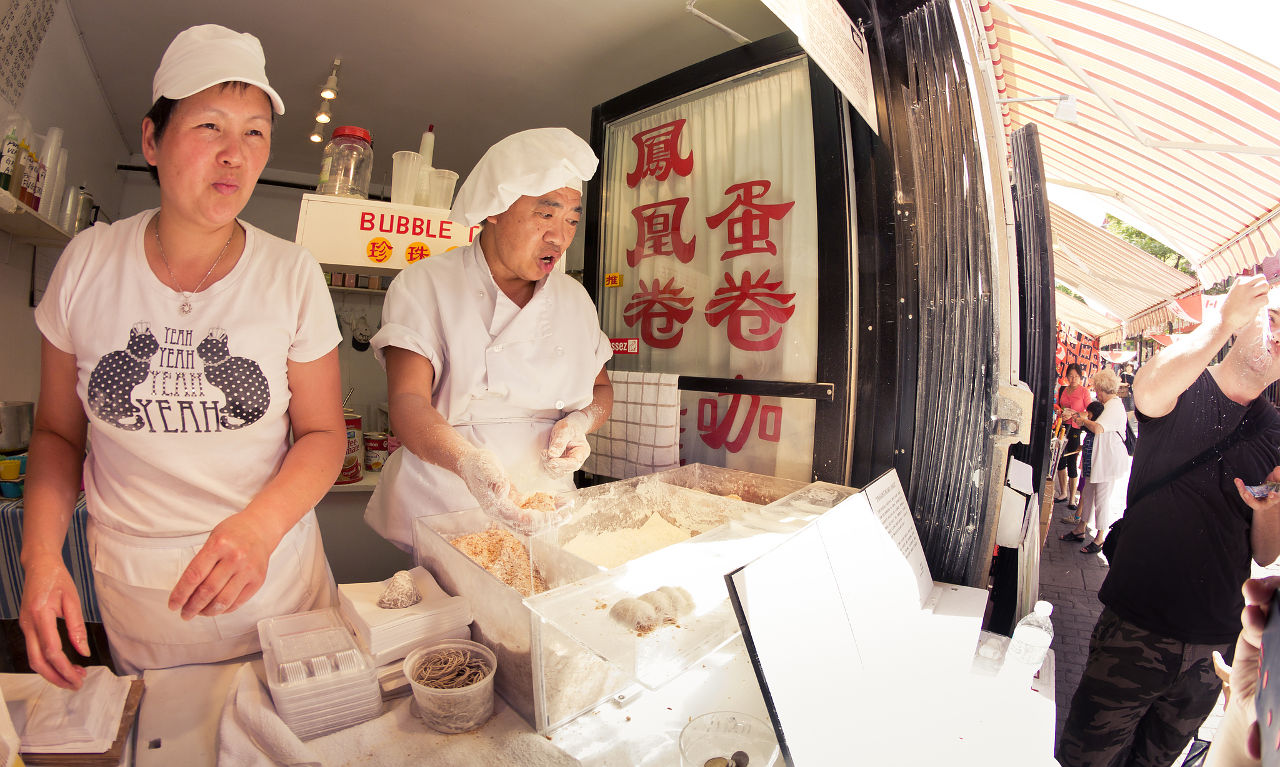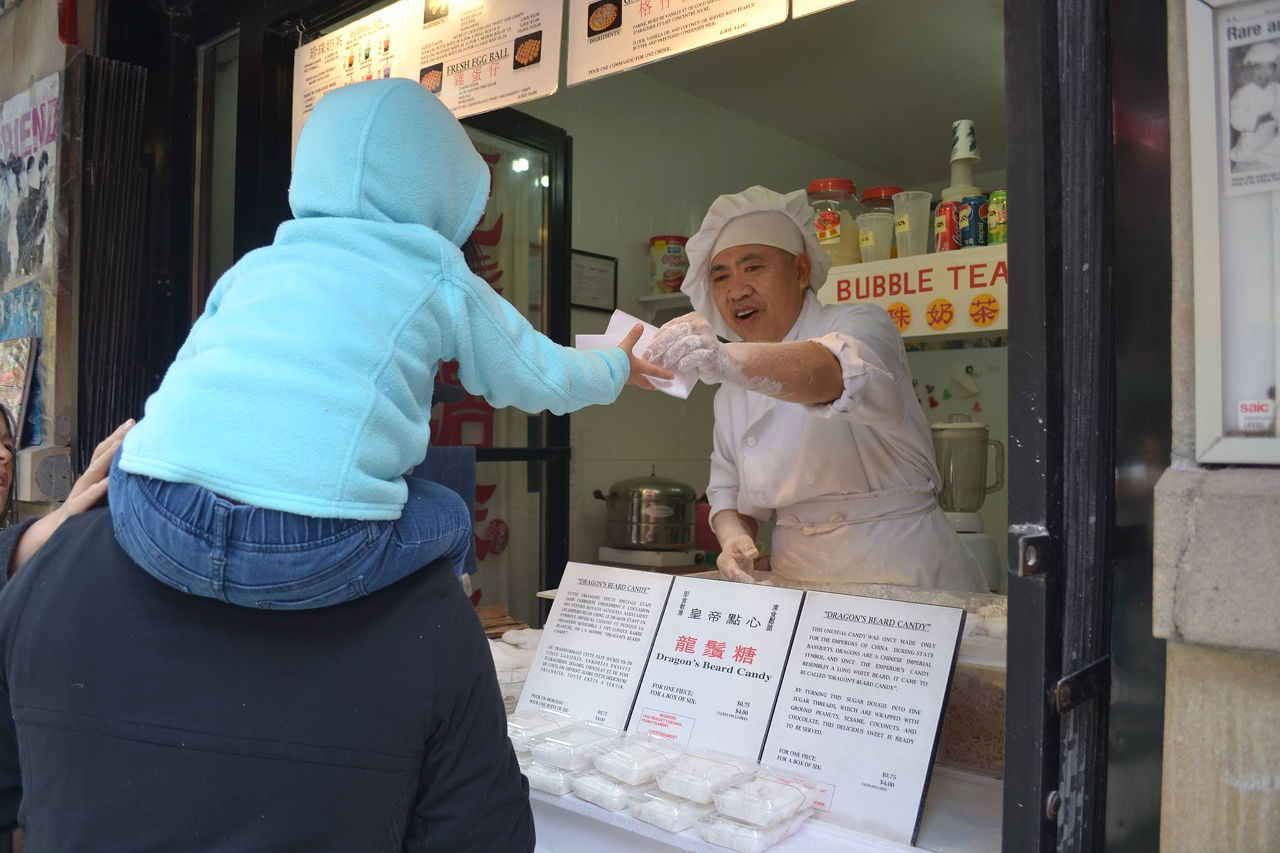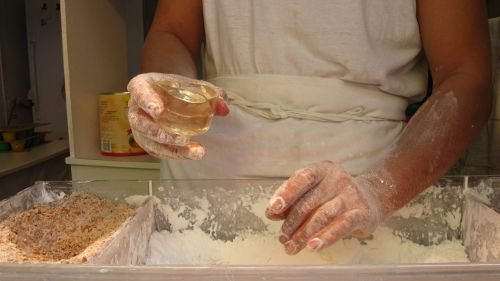by Evelyn Reid
Originally published on About.com April 18, 2009

Dragon beard candy bought from Chinatown in London.
Photo by Richard Lai (Public Domain)
But what makes Montreal’s source of dragon beard candy so special?
According to Johnny Chin, he confects it fresh on the spot seven days a week. Save a stand in the Hong Kong International Airport that sells candy “seven times more expensive than mine,” he says, “my shop might be the only place in the world that sells dragon beard candy every day.”

Dragon beard candy master Johnny Chin making his specialty in Montreal’s Chinatown.
Photo by Flickr user Mike (CC BY-SA 2.0)
Dragon Beard Candy: A Little History
The legend of dragon beard candy dates back at least 2,000 years but no one is sure of the exact season, decade, or even century it was first made. Dragon beard candy masters, including Montreal’s Johnny Chin, say it was created some time during the Han Dynasty that lasted over 400 years.
So once upon a day between 206 BCE and 220 CE, a Chinese Imperial Court chef wanted to please an emperor with a new confection. The fine silky strands that characterize the candy perhaps reminded the chef or someone in the Imperial Court of a dragon’s beard—alternatively, Toronto’s Jimmy Poon says it was first called cat beard candy because of how the candy can stick to your face. Nonetheless, the mythical dragon is the symbol of Chinese emperors, so naming it dragon beard candy must have seemed appropriate, especially since it was strictly reserved for emperors and maybe entourage at state banquets.
Centuries later, the art persisted, escaping the confines of the Forbidden City and brought forth to the general public. Chin’s childhood memories include delighting in masters creating the candy’s many thousand threads out of sugar on the streets of Hong Kong.
But then came the Chinese cultural revolution, nearly extinguishing over two thousand years of ancient candy making in the span of a decade, with the Red Guard threatening the execution of anyone engaging in activities linked to the West or old world China.
Even though then British-ruled Hong Kong was spared mainland China’s fate, the art nearly died. In 1991, Johnny Chin claimed that less than a dozen dragon beard candy masters were left in the world.
Who Is Johnny Chin?
In the ’80s, Bishop’s University graduate Johnny Chin was working at the senior executive level as a financial controller for a Montreal company, seemingly on the fast track to financial security, enhanced social status, and career success. But he wasn’t particularly happy.
Returning to his hometown of Hong Kong, he discovered the ancient art of dragon beard candy that charmed him as a child was on the brink of extinction as a direct result of the cultural revolution. By the late ’80s, there were maybe four dragon beard masters left in Hong Kong. One of them was Chin’s brother, who bribed a disgruntled elderly master into sharing the secret of the dragon beard for $5,000.
Apprenticing under his brother, Chin perfected the art—it can take months, even years, to master the twist-pull technique that crafts the candy’s hair-like strands—and then returned to Montreal in 1991, intent on introducing the theatrical candy-making skill to North America, concerned that part of his heritage would vanish. “That’s why I want to make the candy—to preserve part of my culture,” Chin told The Gazette in 1991. He was also smitten by the idea of being able to interact with the community in ways he never could as a number-crunching controller.
Almost twenty years later with two children in tow—who may very well follow in Dad’s footsteps—Johnny Chin still works seven days a week in his Montreal Chinatown shop, happier than his executive job ever made him. And thanks to his customers, a blend of tourists and locals, he’s become somewhat of a polyglot, picking up bits of Italian and Spanish in addition to speaking fluent English, French and his first language, Cantonese.
Keep any eye out for his open-air storefront stand on on de la Gauchetière Street.

Above: Johnny Chin serving customers in his infamous Montreal Chinatown storefront. (Photo courtesy of Johnny Chin)
Dragon Beard Candy in Montreal and Around the World
by Evelyn Reid
Originally published on About.com April 18, 2009

Apart from Hong Kong where dragon beard candy is common, there are but a handful of places in the world that sell the ancient Chinese confection originally reserved for aristocracy. Though it’s possible to order dragon beard candy online with a bit of sleuthing, the candy’s shelf life is short and besides, nothing comes close to eating it freshly prepared, its mouth-melting cotton candy-like debut ending with a chewy, nutty nougat finish.
Dragon beard candy stands have been spotted in Beijing, Taipei, and Singapore as well as New York City, Boston, Vancouver and Toronto, though its first Western roots sprung in Montreal according to Johnny Chin, a dragon beard candy master who claims he introduced the delicacy to North America, back in November 1991.

Dragon’s beard candy bought from Chinatown, London. (Photo by Richard Lai, Public Domain)
But what makes Montreal’s source of dragon beard candy so special?
According to Johnny Chin, he confects it fresh on the spot seven days a week. Save a stand in the Hong Kong International Airport that sells candy “seven times more expensive than mine,” he says, “my shop might be the only place in the world that sells dragon beard candy every day.”

Dragon beard candy master Johnny Chin making his specialty in Montreal’s Chinatown. (Photo by Flickr user Mike (CC BY-SA 2.0))
Dragon Beard Candy: A Little History
The legend of dragon beard candy dates back at least 2,000 years but no one is sure of the exact season, decade, or even century it was first made. Dragon beard candy masters, including Montreal’s Johnny Chin, say it was created some time during the Han Dynasty that lasted over 400 years.
So once upon a day between 206 BCE and 220 CE, a Chinese Imperial Court chef wanted to please an emperor with a new confection. The fine silky strands that characterize the candy perhaps reminded the chef or someone in the Imperial Court of a dragon’s beard—alternatively, Toronto’s Jimmy Poon says it was first called cat beard candy because of how the candy can stick to your face. Nonetheless, the mythical dragon is the symbol of Chinese emperors, so naming it dragon beard candy must have seemed appropriate, especially since it was strictly reserved for emperors and maybe entourage at state banquets.
Centuries later, the art persisted, escaping the confines of the Forbidden City and brought forth to the general public. Chin’s childhood memories include delighting in masters creating the candy’s many thousand threads out of sugar on the streets of Hong Kong.
But then came the Chinese cultural revolution, nearly extinguishing over two thousand years of ancient candy making in the span of a decade, with the Red Guard threatening the execution of anyone engaging in activities linked to the West or old world China.
Even though then British-ruled Hong Kong was spared mainland China’s fate, the art nearly died. In 1991, Johnny Chin claimed that less than a dozen dragon beard candy masters were left in the world.

Above: Johnny Chin serving customers in his infamous Montreal Chinatown storefront. (Photo courtesy of Johnny Chin)
How to Make Dragon Beard Candy in 4 Steps

Step 1 Take a solid but gooey chunk of either sugar, corn syrup, or sugar cane based gel (here’s a video that shows how the gel is made) and dip it in sugar dough so it doesn’t stick all over your hands.

Step 2 Cover the gooey chunk of sugar or corn syrup gel in rice flour so that it doesn’t stick to the hands and then shape it into a donut, this, in preparation for the twist and pull motion essential to the proper formation of the candy’s hair-like strands.

Step 3 Is it slight of hand or years of practice which explains how Johnny Chin transforms a chunk of jelly goo into 8,192 paper thin strands in 40 seconds?
The secret to making dragon beard candy is deceptively simple: pull out the sugar gel donut and then twist it into a figure 8, then double the 8 unto itself. Repeat this sequence no more than 13 times.

Step 4 Once crafted, take the 8,192 strands of paper thin sugar and cut them into a more manageable length, about 4 or 5 inches long, and gently wrap the silky threads in a circular fashion around a small handful of ground peanuts, chocolate bits, coconut flakes, and sesame seeds.

Step 5 Serve immediately. Dragon beard candy is best sampled within the first 30 minutes it’s crafted—the sooner, the better—to guarantee a melt in your mouthfeel. Any later and the sugary strands risk stiffening or altogether melting.
Who Is Johnny Chin?
In the ’80s, Bishop’s University graduate Johnny Chin was working at the senior executive level as a financial controller for a Montreal company, seemingly on the fast track to financial security, enhanced social status, and career success. But he wasn’t particularly happy.
Returning to his hometown of Hong Kong, he discovered the ancient art of dragon beard candy that charmed him as a child was on the brink of extinction as a direct result of the cultural revolution. By the late ’80s, there were maybe four dragon beard masters left in Hong Kong. One of them was Chin’s brother, who bribed a disgruntled elderly master into sharing the secret of the dragon beard for $5,000.
Apprenticing under his brother, Chin perfected the art—it can take months, even years, to master the twist-pull technique that crafts the candy’s hair-like strands—and then returned to Montreal in 1991, intent on introducing the theatrical candy-making skill to North America, concerned that part of his heritage would vanish. “That’s why I want to make the candy—to preserve part of my culture,” Chin told The Gazette in 1991. He was also smitten by the idea of being able to interact with the community in ways he never could as a number-crunching controller.
Almost twenty years later with two children in tow—who may very well follow in Dad’s footsteps—Johnny Chin still works seven days a week in his Montreal Chinatown shop, happier than his executive job ever made him. And thanks to his customers, a blend of tourists and locals, he’s become somewhat of a polyglot, picking up bits of Italian and Spanish in addition to speaking fluent English, French and his first language, Cantonese.
Keep any eye out for his open-air storefront stand on on de la Gauchetière Street.
